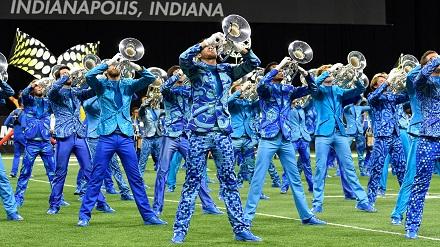
For nearly a half century, Drum Corps International, Marching Music’s Major League™, has been the leader in producing events for the world’s most elite and exclusive marching ensembles for student musicians and performers. From its founding in 1971 to its establishment of an official non-profit entity in 1972, DCI supports numerous programs around the globe while sanctioning participating recognized drum corps, SoundSport® performance ensembles and DrumLine Battle™ teams performing in more than 100 competitive events that make up the annual Drum Corps International Tour. Each division crowns a world champion at the end of the season.
With a vast reach online at DCI.org through corporate sponsorship, annual broadcast initiatives, and outreach to high school music programs, Drum Corps International delivers the message of “excellence in performance and in life” to more than 7.2 million young people, ages 13-22 involved in the performing arts across the United States.

Barbara Nash: DCI is actually somewhat like a club sport forthemarching arts – it is an organization that puts on a season-long, mid-June to mid-August, tour and competition for independent drum corps. These organizations have the best performers in their fields.
Dan Acheson: DCI is known as the Marching Music’s Major League for a reason – it’s very inspiring to watch the performances and we know people go home with a lot of ideas. Our performers really are the best of the best; each year, more than 12,000 people audition for positions with these organizations and less than half of them will be accepted.
SDM: Did it start as marching bands?
Dan Acheson: In a way. It is a sport that was born out of the way military groups formed and performed in World War I – you might refer to that group as drum corps. Our groups are marching bands with brass and percussion, as well as flags, sabers, rifles and dancers – we’d call them the color guard.
SDM: Has the way music is performed changed over the years?
 Acheson: Oh, yes – it used to be very block and marching focused, but now, it’s very theatrical. I see it as a journey of transformation. It keeps evolving. Just 10 years ago, we introduced amplification and electronics – it’s not just instruments. More of the audience can enjoy what is happening. We’ve added vocalists as well. Something that sometimes surprises people is most stadiums fill to one side and a little in the end zone because our performers are usually facing in one direction as they perform.
Acheson: Oh, yes – it used to be very block and marching focused, but now, it’s very theatrical. I see it as a journey of transformation. It keeps evolving. Just 10 years ago, we introduced amplification and electronics – it’s not just instruments. More of the audience can enjoy what is happening. We’ve added vocalists as well. Something that sometimes surprises people is most stadiums fill to one side and a little in the end zone because our performers are usually facing in one direction as they perform.
Editor’s note: DCI’s YouTube Channel, available by subscription, can be found here.
SDM: How many music groups go on the tour each summer? Are they all from one region or are they from around the country?
Acheson: We have 45 drum corps that participate on our tour. They are dispersed around the country geographically, from the East, West, Midwest, South and so on. We also have international SoundSport® organizations from Canada, Colombia, Costa Rica, andSoutheast Asia, among others. The maximum size of each competing drum corps is 154 people, which includes about 80 brass, 36 color guard and the remainder being percussion. Each corps also has a staff that travels with the tourin addition to the DCI event staff.
 SDM: That is an enormous number of people and musical instruments to move from place to place. What are the logistics like?
SDM: That is an enormous number of people and musical instruments to move from place to place. What are the logistics like?
Nash: The drum corps travel across the country in busesaccompanied by equipment tractor trailer rigs, food trucks, and vans. To give you an idea of the logistics, a corps arrives in a cityand goes to an assigned housing site, which is often a local middle school or high school. There, the corps members sleep on cots and air mattresses in the gym and use the locker rooms and other school facilities to rehearse the next day. Then they pack up, go to the competition venue, perform - and head for the next city.
SDM: That is quite a production. Where is everything stored while people are rehearsing and before they perform at competitions?
Acheson: We use a lot of parking lots.
SDM: It sounds like trying to set up and break down the Super Bowl halftime show over and over and over.
Nash: It’s not that far off!
 SDM: Getting back to DCI’s stay in cities, it seems they don’t generally make arrangements like hotel room blocks or working with housing bureaus.
SDM: Getting back to DCI’s stay in cities, it seems they don’t generally make arrangements like hotel room blocks or working with housing bureaus.
Acheson: The way the schedule is, it would be very challenging to have all the performers checking into hotels all at once, getting enough sleep, then getting showered and dressed and packed up and checking out, then getting to rehearsal – it just wouldn’t fit the time constraints.
Nash: One really interesting thing is that wherever each organization practices, it’s never to empty stands. There are always high school and college bands and their directors who come in to watch.
SDM: Do high school and college groups ever approach you for ideas?
Acheson: Often, we’ll host clinics or other outreach events in the cities we visit.
SDM: Getting back to the summer tour, what do you look for when you choose cities to stop in and for the regionals?
Acheson: We want to go to a market in where they have massive high school stadiums we can use for our practices. Obviously, a small field won’t work. For regional competitions, we use college or professional stadiums. Another factor in choosing cities is whether they have a history of having hosted marching events or having schools that compete in them because that means you have an audience.
 SDM: Given that these events are outside in the summer, how do you deal with rainouts?
SDM: Given that these events are outside in the summer, how do you deal with rainouts?
Acheson: Disappointingly this year, we had to deal with rainouts twice. Playing in the rain is impossible because the instruments now are so much more sophisticated, and they can be damaged by water. Lightning is also obviously an issue; we can’t send people out on a field in dangerous conditions. If it’s stopped raining and the field is wet, that’s one thing – we institute a standstill protocol. Groups can stand in formation and play but we can’t have them doing the choreography because it’s just too dangerous to be running around on a wet surface. That particular competition becomes an exhibition at that point. It’s disappointing for the audiences to have a rainout or to miss out on the choreography, but believe me, the performers are even more disappointed.
SDM: What do you think are some of the mistaken ideas about marching music?
Acheson: People think that the performers are not athletes. Watch any of the performances and you see these kids in constant motion. In a 13-minute performance, they’re running, marching and dancing in their drill formationswhile carrying instruments, some of which are really heavy. This past year, I made a presentation at a convention of athletic trainers. I showed them a clip of one of our performances,and it really took them by surprise. Nobody understands how physically demanding this is. Many of our corps have nutritionists and chefs on the tour with them to make sure the performers eat the right foods, usually with four meals a day. I would also say that another misconception is that these kids are not popular in school. In reality, they tend to be brilliant students who are engaged in a variety of activities and who aspire to be important parts of our society.
 SDM: What is the economic impact for DCI’s events?
SDM: What is the economic impact for DCI’s events?
Acheson: It depends on the venue and the event. In Indianapolis where we hold our World Championships, the convention and visitors bureau estimated a $12 million economic impact just for the one week we hold our events there. Our regional events are one- or two-day events and they bring in approximately $3 million to each of those cities. It’s challenging for us to estimate because, as we said earlier, our performers don’t stay in hotels and we also do our own cooking for everyone on the tour. The impact comes from spectators and families – our championships in Indy had 25,000 in attendance.
SDM: Are the spectators family and friends of the performers?
Acheson: Family and friends do come, but the larger part of our audience is made up of marching bands and music teachers and band directors in the areas of the events. There is also a lot of interest among people who used to play in high school or college band, and who have great memories about going to competitions.
SDM: Is there money at stake for the championships?
 Nash: No, just bragging rights. It’s friendly competition. In fact, it’s not uncommon for several corps members to be at the same college, all be friends during the school year, and still participate in competing organizations in DCI during the summer.
Nash: No, just bragging rights. It’s friendly competition. In fact, it’s not uncommon for several corps members to be at the same college, all be friends during the school year, and still participate in competing organizations in DCI during the summer.
SDM: Do the judges come from the local area where you are performing each time?
Acheson: No, throughout the tour, we have eight judges assigned to each regional event. We have a pool of about 150 judges. We bring between 30 and 50 judges to the world championships alone. Each judge is looking for different things – we have judges for brass, percussion color guard, general effect, visual effect, different techniques. It’s incredibly sophisticated. One year, the margin of victory was .087 of one point.
SDM: What do the performers in DCI want to do, ultimately? Competitive music seems like something that would come to an end after college age.
Acheson: Based on our own internal surveys of the performers, we’ve found that most aspire to have a career with music; they want to be music teachers, band directors, even stage performers. We have some very successful alumni!

 www.dci.org
www.dci.org